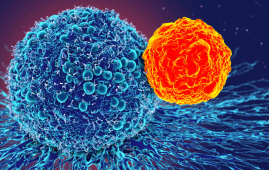

Hearing a newborn’s wail can cause the production of oxytocin, a brain hormone that governs breast milk supply in moms, according to a new mouse study. Researchers discovered that when prompted, this surge of hormones in the brain circuit lasts around five minutes before tapering off, allowing women to feed their babies until they are satisfied or begin screaming again.
The study, led by experts from NYU Grossman School of Medicine, looked into a centuries-old finding in humans and other species that when a baby starts feeding, its cries alone can cause its mother to release breast milk. Decades of research have demonstrated that such pleas for food, rather than suckling, cause the greatest oxytocin spikes. However, the mechanisms and purpose of this wail-to-milk route were unknown until recently.
When a mouse pup starts wailing, sound information flows to a part of its mother’s brain called the posterior intralaminar nucleus of the thalamus (PIL), according to the findings, which were published online September 20 in the journal Nature. This sensory hub then transmits signals to oxytocin-releasing brain cells (neurons) in the hypothalamus, which is a hormone control center.
The majority of the time, these hypothalamic neurons are “locked down” by proteins that serve as gatekeepers, preventing false alarms and wasted milk. However, after 30 seconds of persistent sobbing, signals from the PIL were shown to accumulate and override these inhibitory proteins, triggering oxytocin release.
“Our findings uncover how a crying infant primes its mother’s brain to ready her body for nursing,” said study co-lead author Habon Issa, a graduate student at NYU Langone Health. “Without such preparation, there can be a delay of several minutes between suckling and milk flow, potentially leading to a frustrated baby and stressed parent.”
The findings also demonstrated that the oxytocin surge occurs only in mother mice, not in females that have never given birth. Furthermore, the mother’s brain circuitry responded exclusively to her puppies’ screams, not to computer-generated tones designed to simulate real wails.
The work, according to Issa, provides the first account of how sensory experiences including as hearing directly trigger oxytocin neurons in mothers. She points out that the scientists utilized a relatively new type of molecular sensor called iTango to quantify real-time oxytocin production from brain cells. She claims that before, researchers could only take indirect measures with proxies because the hormone degrades quickly due to its small size.
The researchers studied brain cell activity in dozens of female mice for the study. Then, using a technique known as “reverse engineering,” they identified how sound information flows through different parts of the brain to cause milk flow.
The team then investigated how this circuit influences parenting behavior. According to Issa, when puppies stray or are removed from their nest, their moms will immediately retrieve them no matter how many times this occurs. When the researchers chemically prevented the PIL from interacting with oxytocin neurons, the mice became fatigued and stopped bringing their young. When the system was restored, the women overcame their exhaustion and continued to care for the infants.
“These results suggest that the crying-prompted brain circuit is not only important for nursing behavior, but also for maintaining a mother’s attention over time and encouraging effective care of her young even when she is exhausted,” said study senior author Robert C. Froemke, PhD. Dr. Froemke is the Skirball Professor of Genetics in the Department of Neuroscience and Physiology at NYU Langone.
Dr. Froemke, who is also a professor in the Department of Otolaryngology—Head and Neck Surgery, adds that understanding how the oxytocin system works (and fails) in our own species may offer novel approaches to assist human moms who want to nurse but struggle to do so.
Dr. Froemke, who is also a member of NYU Langone’s Neuroscience Institute, emphasizes that the researchers did not assess lactation per se, but rather the hormone release that causes it.
The research was supported by National Institutes of Health funds T32MH019524, P01NS107616, and DP1MH119428. The Natural Sciences and Engineering Research Council of Canada PGS-D Fellowship and a Howard Hughes Medical Institute Faculty Scholarship provided additional support.
In addition to Issa and Dr. Froemke, the study’s co-lead author was former NYU researcher Silvana Valtcheva, PhD, who is currently at the University of Cologne in Germany. Chloe Blair-Marshall, BS, Kathleen Martin, BS, and Yiyao Zhang, PhD, were also researchers at NYU Langone. Kanghoon Jung, PhD, and Hyung-Bae Kwon, PhD, both of Johns Hopkins University in Baltimore, contributed to the study.
more recommended stories
 T-bet and the Genetic Control of Memory B Cell Differentiation
T-bet and the Genetic Control of Memory B Cell DifferentiationIn a major advancement in immunology,.
 Ultra-Processed Foods May Harm Brain Health in Children
Ultra-Processed Foods May Harm Brain Health in ChildrenUltra-Processed Foods Linked to Cognitive and.
 Parkinson’s Disease Care Advances with Weekly Injectable
Parkinson’s Disease Care Advances with Weekly InjectableA new weekly injectable formulation of.
 Brain’s Biological Age Emerges as Key Health Risk Indicator
Brain’s Biological Age Emerges as Key Health Risk IndicatorClinical Significance of Brain Age in.
 Children’s Health in the United States is Declining!
Children’s Health in the United States is Declining!Summary: A comprehensive analysis of U.S..
 Autoimmune Disorders: ADA2 as a Therapeutic Target
Autoimmune Disorders: ADA2 as a Therapeutic TargetAdenosine deaminase 2 (ADA2) has emerged.
 Is Prediabetes Reversible through Exercise?
Is Prediabetes Reversible through Exercise?150 Minutes of Weekly Exercise May.
 New Blood Cancer Model Unveils Drug Resistance
New Blood Cancer Model Unveils Drug ResistanceNew Lab Model Reveals Gene Mutation.
 Healthy Habits Slash Diverticulitis Risk in Half: Clinical Insights
Healthy Habits Slash Diverticulitis Risk in Half: Clinical InsightsHealthy Habits Slash Diverticulitis Risk in.
 Caffeine and SIDS: A New Prevention Theory
Caffeine and SIDS: A New Prevention TheoryFor the first time in decades,.

Leave a Comment